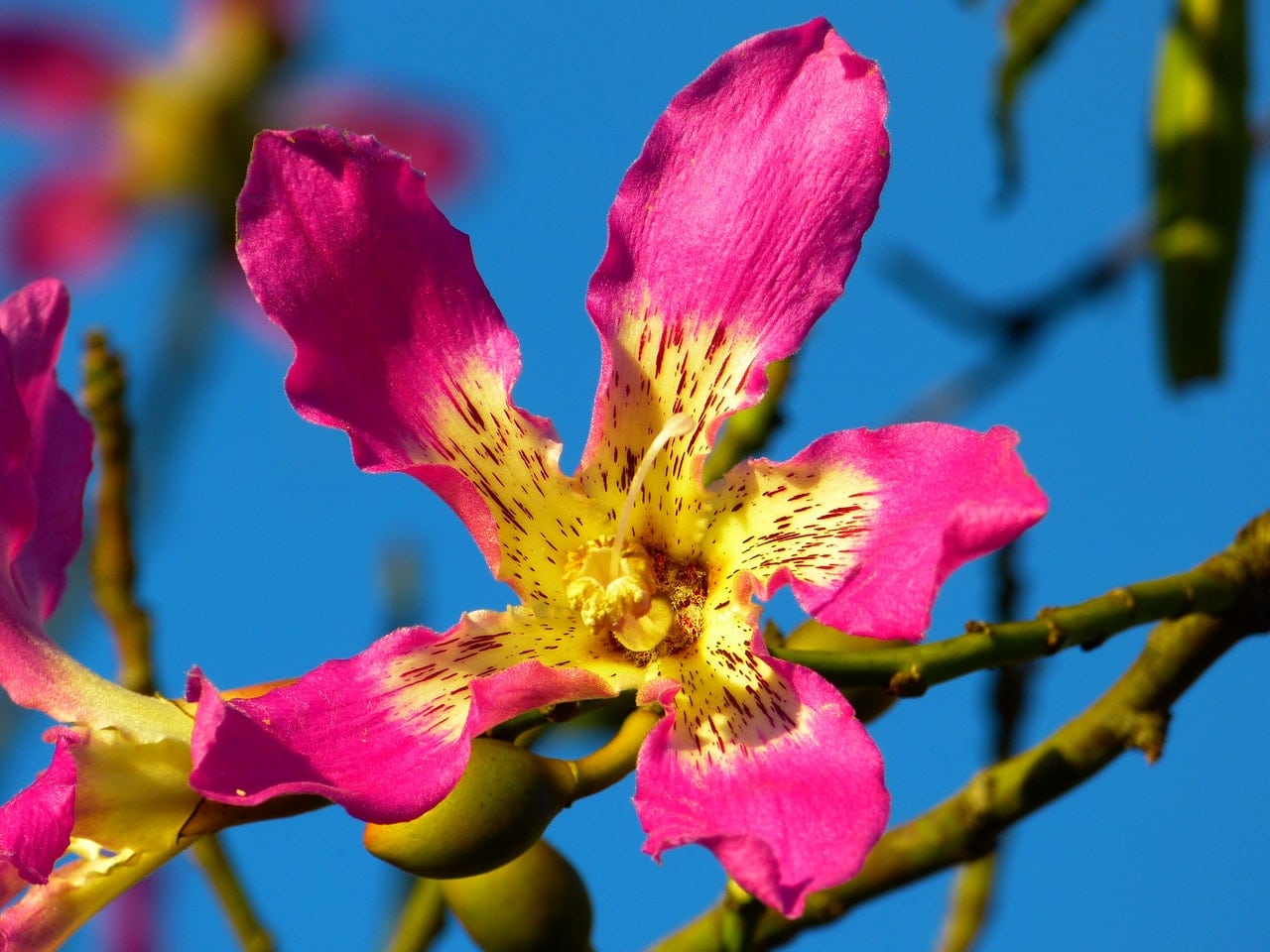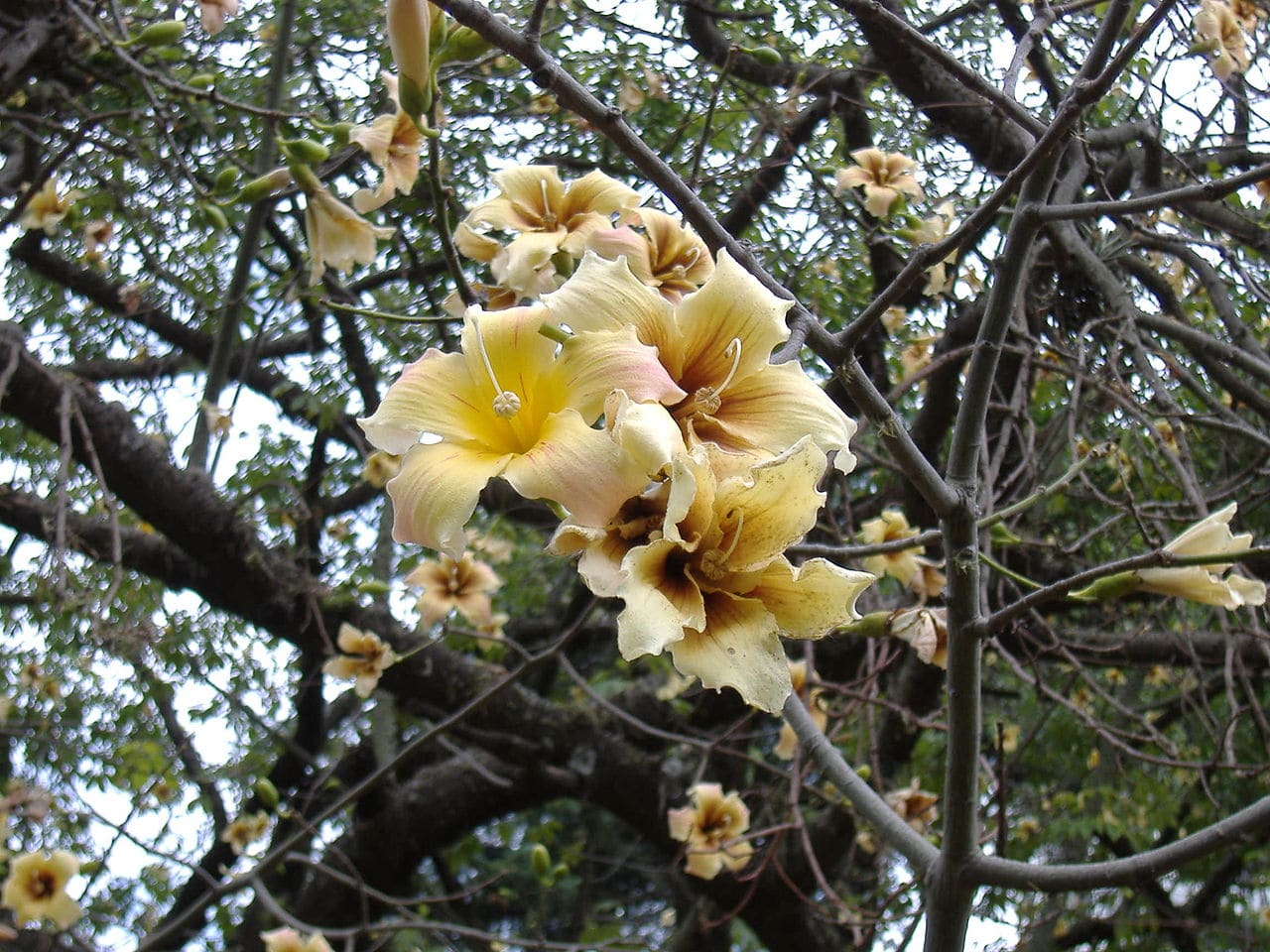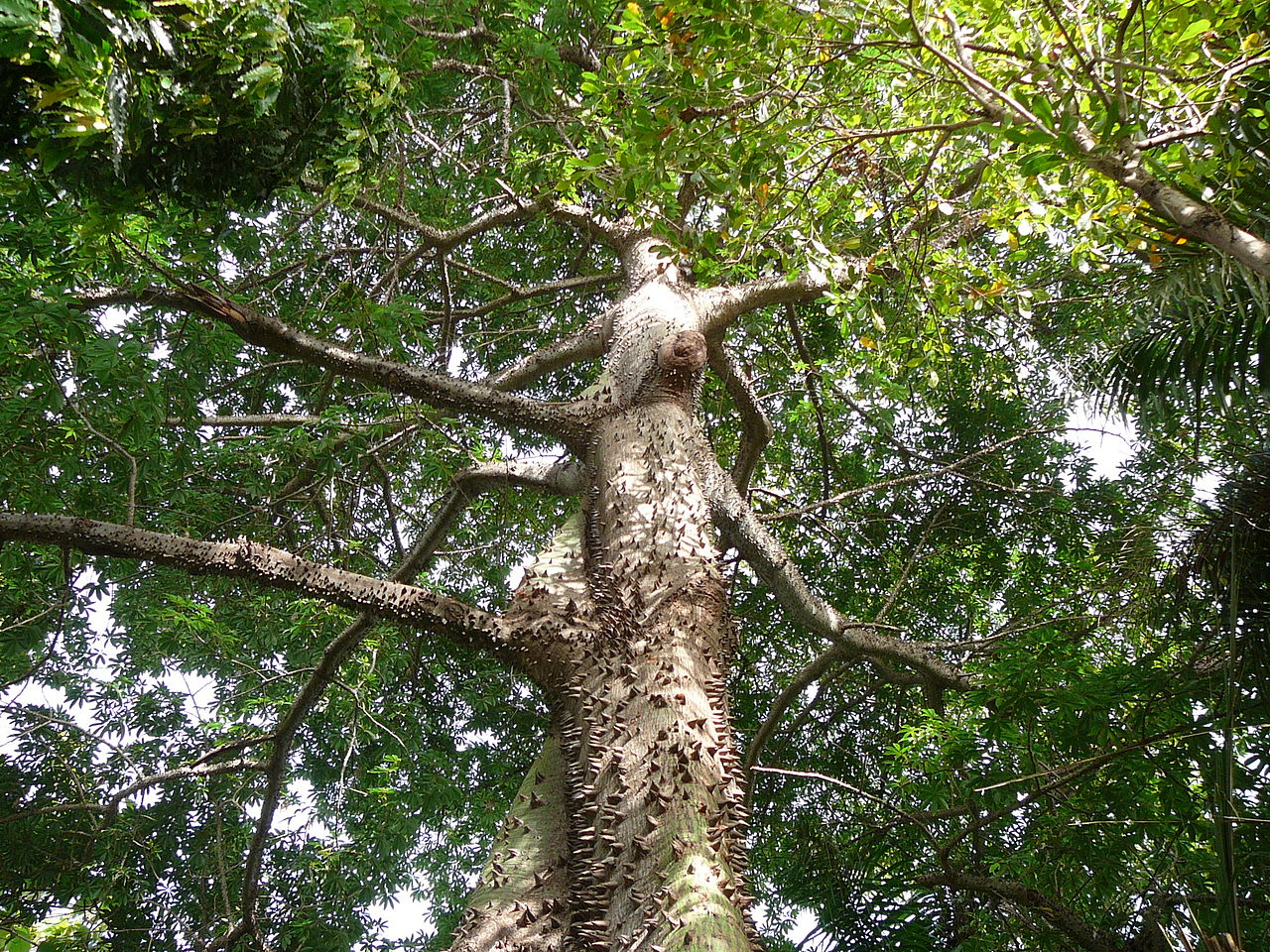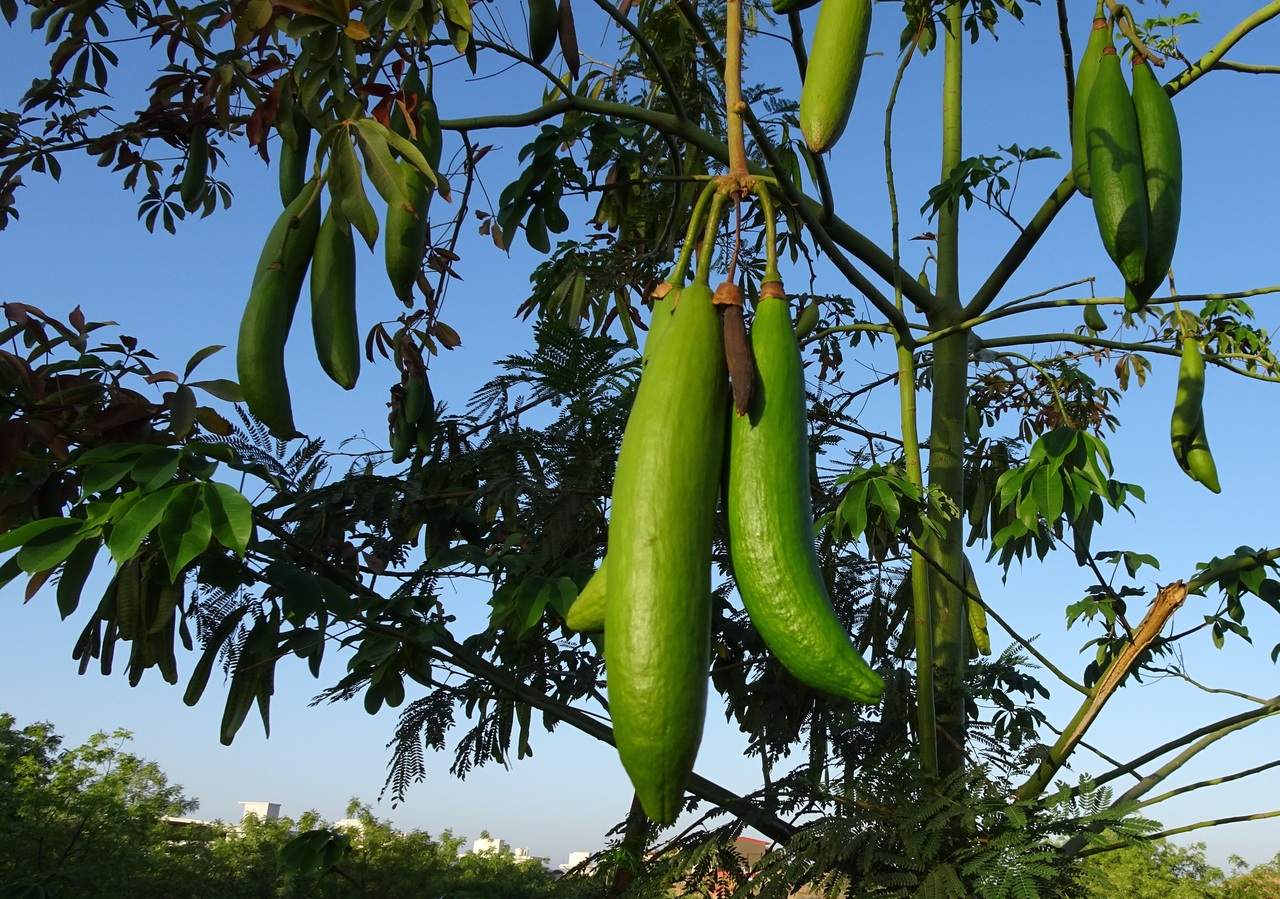
In tropical and humid regions around the world we can find impressive plants, such as the kapok. This imposing tree can reach a height of up to 10 meters, and a trunk thickness of up to 4 meters at its base.
They are much loved in gardens, as they have really decorative flowers. In addition, they provide a very pleasant shade, and do not require much care.
Origin and characteristics of the Ceiba
The Ceiba, also called pochote, is a botanical genus of trees native to Central America. It belongs to the Malvaceae family. Most of the 21 species it comprises are large trees, with palm leaves made up of 5 to 9 green leaflets.
The flowers can be grouped in inflorescences or solitary, and are hermaphroditic. These appear before the tree runs out of its leaf parts, and are commonly pollinated by butterflies, bats, or hummingbirds. The fruit is a woody capsule inside which are the seeds, which are rounded and wrapped in a cottony fiber.
They grow in forests where there is a season marked by drought. However, in cultivation they have been shown to be very adaptable and resistant trees, being able to plant in tropical gardens where they will give a very good shade during the hottest time of the year.
Main species
We have said that the genus is made up of about 21 species, but the best known and, therefore, commercialized are the following:
Ceiba chodatii

Image - Wikimedia / Pablo-flores
It is known as white-flowered palo borracho or yuchán, and it is a deciduous tree endemic to Argentina, Brazil, Bolivia, Paraguay, Peru and Ecuador that reaches a height of 5 to 23 meters. The trunk begins to branch from the end, forming an open and rounded crown composed of thick branches. Its leaves are alternate, palm-composed of 5 leaflets.
The flowers are grouped in creamy white inflorescences, 8 to 15cm long. The fruit is a large capsule inside which contains black seeds.
ceiba pentandra

Image - Wikimedia / Atamari
It is known as ceiba or ceibo, and it is a deciduous tree native to the Mesoamerican region that reaches a height of 60 to 70 meters with a trunk up to 3 meters thick. The crown is very wide, formed by branches from which palmate leaves made up of 5 to 9 leaflets sprout.
The flowers are solitary or fasciculate, with pink, white or yellow petals. The fruit is a capsule that contains numerous black seeds.
ceiba speciosa

Known as palo borracho, bottle tree, wool tree, rosewood, or samohú, it is a deciduous tree native to Peru, Bolivia, Argentina, Paraguay, and Brazil, and by its other scientific name Chorisia speciosa. It reaches a height of 10 to 20 meters, although it can exceed 25 meters. The trunk is acquiring the shape of a bottle, and is protected with thick stingers. The leaves are compound, and it has 5 to 7 leaflets.
The flowers are large, creamy white in the center and pink in the distal area. The fruit is an ovoid capsule that contains numerous black seeds.
What are their cares?
This is a tree that needs a lot of room to grow, so if you have a large plot of land and you are looking for a decorative plant that is easy to care for, the Ceiba is for you. Not sure what you need to look healthy? Do not worry. We tell you everything you need to know to take care of it. Take note:
Location
To your plant you should place it in an area where it receives sunlight all day for excellent growth and development. In addition, it is very important that it is at a minimum distance of ten meters, since its roots can cause problems if they are near pipes, paved floors, etc.
Earth
- Garden: without soil requirements, but prefers well-drained land rich in organic matter.
- Flower pot: we recommend filling it with a porous substrate in order to avoid waterlogging.
Irrigation
They are trees that want water, but not too much. The frequency of irrigation should be moderate, that is, two-three times a week in summer and one-two times a week the rest of the year.
Water thoroughly, moistening all the soil or substrate well. And do not wet the leaves or flowers as they could burn.
Fertilizer
It is highly advisable to fertilize with organic fertilizers such as guano or worm castings throughout the growing season (from spring to early fall).
Ceiba tree multiplication

Ceiba trees multiply by seeds and cuttings in spring:
Seeds
The seeds have to be placed in a glass with water at room temperature for 24 hours, and the next day they have to be sown in a pot -with holes in its base- with soil for seedlings (for sale here) so that they are as far apart as possible. In this way, the ideal is not to put more than 3 seeds in a container of up to 20cm in diameterWell, this way everyone will have the same possibilities to grow and have a good development.
Do not bury them too much: a little is enough, so that they are not very exposed to environmental factors (wind, direct sunlight, etc.), and finally water.
If all goes well, in about 15 to 20 days they will germinate.
Cuttings
To multiply the ceiba by cuttings you have to cut a branch of about 40 centimeters, impregnate the base with homemade rooting agents and plant it (not nail it) in a pot with vermiculite previously moistened with water.
Place it in semi-shade, and go watering every time you see that the substrate is drying. In about 20-25 days it will start to root.
Planting or transplanting time
It has to be planted in spring, when the minimum temperature is at least 15ºC. If you have it in a pot, transplant it every 2-3 years, when you see roots coming out of the drainage holes or if you see that its roots have already occupied the entire container.
Rusticity of the ceibas
It depends on the species. Ceiba trees are tropical trees that resist cold well, but frost hurts them. The most rustic is the ceiba speciosa, which withstands temperatures down to -7ºC.
Uses of pochote
They have several:
- Ornamental: without a doubt it is the use that is given the most. As isolated specimens in spacious gardens they are great, since they also provide very good shade.
- Culinary: the immature fruits, seeds and roots of some species, such as ceiba pentandra, they are edible.
- As filler: the fibrous tissue that the fruits have is used to fill pillows.
- Wood: The wood from the trunk is used to make furniture.
Enjoy your Ceiba 🙂.
Hi Monica, see what we want to buy a ceiba orchid tree, where can you buy it?
Hi Eloisa.
You will find it in nurseries, or in online stores.
a greeting
Hello, I have a mini ceiba that grew under its mother, I put it in a clay pot and I took it with soil from the place I got it. She is now 3 months old and has grown to around 25cm, she was 2cm when I took her out. What should I do to keep it growing? I have it in shadow, because when I was little I gave it the shadow of its mother thanks
Hi Gisela.
Now that it measures 25 centimeters, you can consider planting it in the ground, or in a larger pot.
In any case, it is a tree that grows in the sun, so in spring it is a good time to start getting used to the star king, little by little and gradually. First 1-2 hours of direct light (the first in the morning), and little by little increase the exposure time.
Regards!
Hi there! Monica, one of my Ceiba trees is turning yellow, and its leaves are falling, what could it be? Thank you.
Hi Alex.
If the leaves turn yellow, it may be from irrigation or pest problems.
I recommend spraying them with Neem Oil, or with a broad spectrum insecticide, and watering 3 times a week.
If they still do not improve, treat them with a fungicide after 14 days after being treated with the insecticide.
A greeting.
I have a ceiba ..
But the leaves that come out disappear, some animal is eating them, what can I do ...?
Hi Patricia.
Do you know what animal it can be? If it is an insect, you can treat it with Chlorpyrifos, but if it is a larger animal, I would recommend protecting the tree with a screen.
If you want, upload an image to tinypic or imageshack of the affected leaves of your tree, copy the link here and I'll tell you.
A greeting.
Hello, good afternoon!!! I have a ceiba tree, I live in Mexicali where there is a temperature of 41 degrees Celsius right now in summer, for that reason I water it every day, it is in a large pot, but I have noticed that the thorns are falling off. shall? I would appreciate your opinion, thank you !!!
Hi Cynthia.
If the tree is healthy, I wouldn't worry. This usually happens to ceibas, that either they have a trunk full of thorns all their lives, or they do not have any, or they drop some.
In the event that it worsens, for example, that the leaves begin to yellow and fall, decrease the frequency of watering.
A greeting.
Where I live there is a huge Ceiba tree, I came to live there about 7 years ago and it had never given flowers until now, I can only say that it is a very beautiful tree, the only thing is when it throws all its leaves and now with the flowers I have to sweep daily because he throws too many hehe but I love that tree.
Hi Macarena.
Yes, they are things that he has
And I agree, the tree is very beautiful, especially when it is in bloom 🙂
Greetings.
Hello, I have a ceiba tree and as a result of the cold here it ran out of leaves, I am worried that they will no longer grow and it is dying how can I know if it is okay
Hello Damaris.
You can scratch the trunk or branches a bit. If they are green, it is because the plant is alive.
Anyway, in principle there is nothing to worry about.
It sure sprouts in spring.
A greeting.
Hello, they gave me a Ceiba ... they tell me that it will grow a lot and it gives me a little fear because it is near the construction of my house, it is still a young tree, I can prune it so that it does not grow so much or it would be better to remove it from that place and plant it In another side.
It is my first tree that I see growing but everyone says that it will grow a lot ... I don't know what to do and I would like to keep it and I thought maybe I could prune it, what do you advise me?
Thank you
Hello Rita.
Yes, the ceiba grows a lot. The ideal is to go pruning to control it.
If you have any questions, write to us at Facebook sending us a photo and we will tell you.
A greeting.
Hi, I'm Monica and I live in Chiapas, Mexico, I have 2 ceibas in my garden, they are approximately 4 years old, they are large and robust about 5 meters high, one of them approximately 6 months ago (I think it was summer) threw all the The leaves remain the pure branches and the leaves have never come out again, it has been like this for about 6 months, the stem and the branches look green, what could it be? What solution is there? Spring is approaching and the other ceiba has already thrown leaves and new ones are coming out, but the ceiba in question has nothing.
Hello Monica.
It is quite possible that you need more nutrients than the other. Plants, although they come from the same parents, each have their own needs.
I recommend you add organic compost, such as guano for example, around the trunk.
A greeting.
Hello, how am I from Venezuela?
Edo guarico transplant a ceiba tree as soon as it reaches its enormous size? And how I take care of it so that it grows well and fast
Hello Daniel.
It will depend on the growing conditions, but if everything is fine, in about 7-8 years.
The article explains how to take care of it.
A greeting.
Hello, I live in Mexico City and they gave me a ceiba tree recently, it occurred to me to plant it outside my house, I had no idea how much they can grow, I don't want us to have problems with size later and have to cut it, way to control its size with pruning?
Hi Mitzi.
In principle, this is not a tree to be pruned, as it could lose its natural shape.
Now, if it is planted in small gardens, it can be pruned. But these pruning should not be drastic; In other words, it is better to cut a little at a time for several years than to do a radical pruning once.
Prune it in late winter, and when it starts to bloom, do it in fall when it loses its leaves.
If you have any further questions, ask.
Greetings.
Hello, I am from Mexico City and 15 days ago they gave me a Ceiba but I am seeing that the leaves are turning yellow and some are nibbled, what can I do to make it better
Hi Berenice.
It is normal for some leaves to yellow and fall during the first days and weeks. I recommend you water it about 2 times a week, and treat it with a broad spectrum insecticide to eliminate the pest that is affecting it.
Greetings.
I'M CONCERNED ABOUT MY CEIBA, I HAVE HAD IT SINCE IT WAS SEED, 6 OR 8 MONTHS AGO I TRANSPLANTED IT TO MY BENCH, I NEVER THOUGHT THAT IT WOULD GROW AS MUCH AS THIS ARTICLE SAYS, BECAUSE I TAKEN THE SEED FROM A CHURCH AND THE TREES WERE NOT SO BIG.
I DON'T WANT IT TO DIE, I DON'T WANT TO CUT IT; BUT I DON'T KNOW IF I CAN STILL TRANSPLANT IT.
GUIDE ME PLEASE….
Hello Maria del Rosario.
If it's only 6-8 months old, you can still get it out of the ground. But for that you have to make trenches about 40cm deep and at a distance of 40cm from the trunk, and in order to remove it with as many roots as possible.
Greetings.
Hello Monica, I will tell you that my neighbor has two ceibas but they are just 40 cm from my hall, since we do not have perimeter walls. The trees are one year old and are about 2 meters 50 centimeters, I am worried that they will damage my property and I asked him to move them but he does not give way, one of the trees is 50 cm from his house. I asked him to cut his branches but he also refused because he could die my question is .. can he really be harmed if he prunes his branches?
Hello Angelica.
Well, pruning is still a practice that hurts the tree, because you are removing branches.
But if they are only one year old, the ceiba can tolerate a change of site. You just have to remove it with as many roots as possible, making deep trenches around the trunk and then carefully remove it.
Greetings.